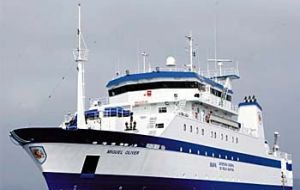MercoPress. South Atlantic News Agency
South Atlantic: Spanish vessel completes fisheries study
 Research vessel, the Miguel Oliver. <br>(Photo: INIDEP)
Research vessel, the Miguel Oliver. <br>(Photo: INIDEP) The research vessel, the Miguel Oliver, owned by the Spanish Government, completed a fisheries resources study of Patagonian platform international waters on 15 April.
For a month, a team of researchers performed tests between parallels 48º and 44º latitude South and Argentina's Exclusive Economic Zone (EEZ) to a depth up to 1,500 metres below the surface to assess the abundance index of various species. The fish species studied were: common hake (Merluccius hubbsi), southern hake (Merluccius australis), squid (Illex argentinus and Loligo), golden kingclip (Genypterus blacodes), hoki (Macruronus magellanicus), Patagonian toothfish (Dissostichus eleginoides), southern blue whiting (Micromesistius australis), and tadpole codling (Salilota australis), among others. "A total of 138 catches - lasting 30 minutes each - were undertaken using Lofoten type fishing gear," affirmed the National Institute for Fisheries Research and Development (INIDEP). The scientists, among which were three Argentines, executed tests determining the size, sex, weight, otoliths, and gonads of the different species analysed. Some of the local shipowners expressed unease over the Spanish vessel's activity in that it not only operated outside of the EEZ but also out of Argentine waters, Pescarereports. The Miguel Oliver– measuring 70 metres long and 12 metres wide - had operated in the area assessing marine bottoms and its interaction with marine fish some months ago. Spain's intention is to monitor Argentine fishing grounds ahead of future deals involving Spanish joint capital companies located in Argentina. Other foreign vessels researching the southern waters were: Spain's Hesperides; the United States' Nathaniel Palmer, and the Russian Akademik Sergey Vavilov.(FIS)




Top Comments
Disclaimer & comment rulesCommenting for this story is now closed.
If you have a Facebook account, become a fan and comment on our Facebook Page!